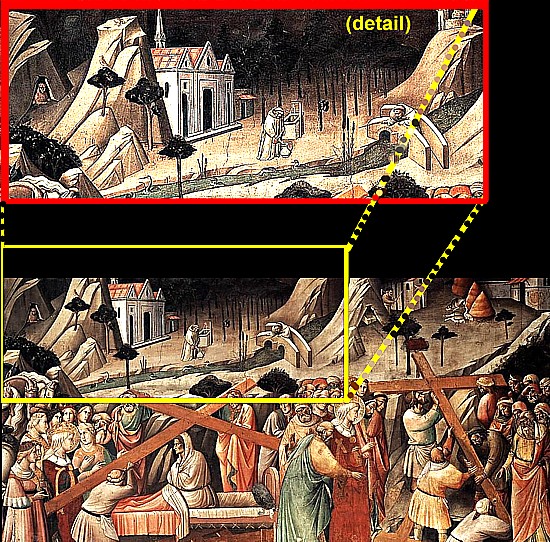 |
| Chancel Chapels seen from west, 1385-87, Frescoes, Santa Croce, Florence, Agnolo Gaddi |
If I were to ask about the top painters of the 14th-century, most people, including those who presumably know something about art, would probably only shrug and reply, Leonardo maybe...Michelangelo perhaps? You'd be wrong in both cases. Leonardo was born in 1452 but was only active from roughly around 1480 until his death in 1519 at the age of sixty-seven. Michelangelo wasn't even born yet in the 14th-century and would have been a mere child during much of the 15th-century, coming of age as a sculptor around 1500, before painting and carving his way into and beyond the Italian Renaissance until his death in 1564 at the age of eighty-nine. Thus, both of these landmark artists were predominantly of the 16th-century art world, not that of the 14th-century, and almost missing out the 15th-century.
 |
| The Three Gaddi family painters, Taddeo, the father, Giovanni, and Agnolo or Angelo, his sons. |
If we are to give credence to Giorgio Vasari, the first and best art historian of his time, and his authoritative tome, Lives of the Most Excellent Painters, Sculptors, and Architects, Agnolo Gaddi was an influential and prolific artist, also the last major Florentine painter descending from Giotto, his father's painting master. Agnolo Gaddi studied under his father, Taddeo Gaddi, as did his less talented older brother, Giovanni, working at various times as his brother's assistant. After the death of Giotto in 1337 Taddeo Gaddi and somewhat later, his sons, became the most prominent artists in Florence.
 |
| Madonna Enthroned with Saints and Angels, 1380-90, Agnolo Gaddi. |
 |
| The Crucifixion, 1390, Agnolo Gaddi. |
Agnolo Gaddi was born in 1350. I think, one of the reasons so many artists fail to recognize the name of such a prominent family of important artist may well be that they take one quick look at what is, in fact, medieval art, perhaps briefly admiring its elegance and delicate beauty, but also noting its apparent crudity as to style (paint-ing as well as draughtsmanship) then get on to the good stuff coming down the road a hundred years later. The reaction would be that, "They couldn't draw very well, or paint much better." Al-though that may tend to be true at times, such as Gaddi's Crucifixion (right), little note is taken that some painters from this era (the Gaddi family among them) were surprisingly good at both. Agnolo Gaddi's Madonna Enthroned with Saints and Angels (above, center), is obviously medieval, but crude it's not.
 |
| Discovery of the True Cross, 1380s, Agnolo Gaddi |
Agnolo Gaddi's Discovery of the True Cross (above) dating from the 1380s, is an even more complex depiction of not just a single event, but a sequence involving the finding of the true cross, all skillfully blended into a single painted image. This technique was common in later years with Christian narrative paintings such as Masaccio's The Tribute Money from 1426-27. Gaddi's work could easily be considered a precursor to that of Masaccio and may have influenced his narrative composition. Agnolo Gaddi died in 1396 at the age of forty-six.
 |
| Madonna col Bambino, 1374, Agnolo Gaddi |
 |
| Like father, like son. Portraits from this period were nearly always in profile. |
No comments:
Post a Comment